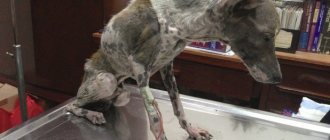Infectious anemia or feline hemobartonellosis (Haemobartonellosis) is one of the infectious diseases that is difficult to diagnose and difficult to treat. The causative agent of the disease is the rickettsia Haemobartonella felis. This intracellular parasite quickly dies outside the body of a warm-blooded animal, and having penetrated its blood cells, it may not manifest itself for a long time. According to veterinary statistics, severe symptoms of the disease are observed in only 25% of animals carrying the infection.
Routes of infection
Although the main host of the rickettsia Haemobartonella felis is warm-blooded vertebrates, it can be transmitted by fleas, mosquitoes, and ticks. A cat can also become infected with hemobartonellosis from a sick animal (for example, during a fight). Infection is possible through a blood transfusion into a cat, or you can get an infection from the mother - in utero or during childbirth.
Attention! Hemobartonella does not parasitize in human blood, so an animal suffering from infectious anemia does not need to be isolated from people.
At risk for infectious anemia are cats with reduced immunity (after childbirth, severe illness, castration surgery or hysterovariectomy), as well as individuals with the presence of feline immunodeficiency virus (FIV) or leukemia virus (FeLV) in their body. It is believed that animals under the age of 3 years are more susceptible to this disease, and cats suffer from hemobartonellosis more often than cats. The likelihood of developing infectious anemia in canines is minimal. In rare cases, it affects dogs who have undergone splenectomy (surgery to remove the spleen) or have severe immunological disorders.
Causes of infection
Piroplasmosis in cats: symptoms and treatment
The main sources of the disease are ticks and fleas. This means that the causes of infection in animals lie in their insect bites. Such sources also cause feline bartonellosis (bartonella).
Other causes of hemobartonellosis include:
- bites received from infected animals;
- contact with animals whose blood contains a rickettsial agent (virus);
- If an adult cat is sick, she can infect her offspring. The infection will begin to be transmitted to the kitten from the mother even before its birth, in the womb, through the placenta. After lambing, they can become infected from their mother's milk.
- during the blood transfusion procedure.
Mechanism of disease development
Haemobartonella felis parasitizes red blood cells (erythrocytes). Once in the cat's blood, rickettsia damages the cell membrane of the red blood cell and penetrates into it, thereby disrupting the structure of blood cells. The result is an attack on one's own red blood cells by microphages, which the immune system sends to destroy the altered red blood cells, considering them foreign elements.
Symptoms of hemobartonellosis in cats
Next, leukocytes-microphages begin to destroy not only diseased, but also healthy erythrocyte cells. A decrease in the number of capable red blood cells in an animal’s blood leads to a decrease in hemoglobin levels and the development of anemia (anemia). The incubation period of the disease is about 3 weeks. In the latent (latent) form of the disease, clinical signs may be absent and appear only when the virus is reactivated.
The course of bartonellosis in dogs
Clinical signs of the disease largely depend on the age and general health of the animal. Puppies and old dogs suffer from the disease more severely than young dogs with strong immune systems. Factors such as the quality of the animal’s diet and the conditions under which it is kept are also important. But, as noted above, a chronic, latent course is typical for bartonellosis. In approximately 70% of cases, bartonella in dogs does not show any symptoms for a long time, or they are so insignificant and vague that they do not suggest a serious illness.
Read 10 symptoms of allergies in dogs and effective ways to treat the disease
But this does not mean that the disease does not pose a threat to the life and health of the dog. Bartonellosis slowly but surely disables the entire animal’s body and primarily attacks the immune system. Sooner or later, the disease goes from a latent form to an acute one - and then the dog begins to have problems with the heart, skin, mucous membranes, eyes, liver, spleen, respiratory tract, lymph nodes and other organs.
Symptoms of hemobartonellosis
Under the influence of factors that cause an immunosuppressive state, the hemobartonellosis virus begins to multiply intensively, and then the manifestations of the disease are not limited to a mild degree of anemia. A cat may experience:
- lethargy, loss of activity, rapid fatigue;
- decreased appetite;
- progressive exhaustion (this most striking symptom of the disease is clearly visible in photos of cats with hemobartonellosis);
- perverted taste preferences (the cat eats sand, paper trash, etc.);
- persistent low-grade fever;
- tachycardia;
- hemorrhages on the conjunctiva;
- yellowness or pallor of mucous membranes.
The duration of the acute period of the disease is about 2 months, then the symptoms may disappear completely, but when a blood test is performed, Haemobartonella felis is found in it - the cat will remain a carrier of the infection forever.
Is feline hemobartonellosis dangerous for humans?
The usual reaction of an animal owner who is diagnosed with cat hemobartonellosis is to understand for himself: is there any danger to his body in particular? Naturally, there is an answer to this question, which will sound like this: no, the disease is not dangerous for humans
. No, no and NO! If you ask the question: why? The answer will be as follows: because this disease does not belong to a number of those diseases that are transmitted from animals to humans.
Moreover, only cats are susceptible to this disease.
. After all, as we remember, the disease has a parallel name, called “infectious anemia in cats.” If you have dogs in your apartment or house, then you shouldn’t worry about them either. Therefore, throughout the entire course of treatment, take care of your beloved pet with all the affection, love, and warmth that you are capable of.
What kind of prevention can be done to prevent cat hemobartonellosis from getting close to the animal?
Although it can be quite difficult to keep track of your pet, because cats themselves are extremely freedom-loving and proud creatures, if you want your cat to always remain in good shape, you still have to take preventive measures. And preventive measures to prevent cat hemobartonellosis will be as follows:
- keeping the animal only in the house. Please note that those cats that constantly live at home almost never suffer from this dangerous and painful disease.
- strengthen your pet's immune system. After all, if a cat has high immunity, it means that the risk of the disease itself will decrease significantly.
- Of course, if you are also involved in breeding animals, you need to make sure of the ideal state of health of your pets more often than usual. Likewise, you should check each of the designated candidates for mating with your cat. Before breeding, be sure to check that all proper veterinary paperwork is in order.
- Don’t forget about proper and harmonious nutrition for your cat and the balance of vitamins.
Never neglect your pet's health. If you are unable to understand what is happening to your cat yourself, contact our veterinary center. Remember in matters of health, time is the most valuable currency of all. The veterinary doctors working with us will be able to quickly make a diagnosis, perform an examination, and perform the necessary injections, if this is, of course, required. Your pet, and in particular your affectionate cat, relies only on you, because she simply has no one else to rely on. Take responsibility, invite a veterinarian to your home or bring her to our veterinary center, we will do the rest ourselves.
Diagnostics
The diagnosis of hemobartonellosis is made on the basis of anamnesis, examination of the animal and the results of blood tests:
- general,
- biochemical,
- blood test for the presence of Haemobartonella felis,
- serological study using the immunofluorescence reaction of antibodies to the pathogen (RIF method),
- PCR method, which allows you to detect the parasite itself in the blood.
There are several reasons for such numerous diagnostic studies. Most of the symptoms of this disease are nonspecific; they are also common to other diseases and are often mildly expressed. Anemia discovered during medical history, examination and a general blood test can also have different origins. In addition, it is not always possible to obtain reliable data.
It is important to know! Haemobartonella felis is not always detected in blood samples. The parasite is able to temporarily leave the body of the red blood cell, and then it will not be identified during the analysis. For this reason, if hemobartonellosis is suspected, the cat’s blood is taken for analysis at least 10 times.
Treatment
Therapeutic measures for feline hemobartonellosis are aimed at removing or mitigating the symptoms of the disease and destroying the parasite. To eliminate (remove) hemabartonella from the body, Levomycetin or tetracycline antibiotics are used. Doxycycline is considered the safest - it has the fewest side effects. The recommended daily dose of Doxycycline is 5÷10 mg per 1 kg of animal weight, take the drug once a day. Recently, a drug that ensures almost complete elimination of rickettsia - Azidin - has become popular among veterinarians in Moscow and St. Petersburg. The optimal daily dose of Azidine for cats is 5 mg per 1 kg of weight.
The course of antibiotics is long, from 2 to 4 weeks, depending on the response to treatment. Therefore, antihistamines are usually included in the treatment program, since the massive death of parasites can cause allergic reactions in a sick cat. To relieve anemia, glucocorticoids are prescribed, most often Prednisolone. It is given to the cat in parallel with antibacterial agents, 1 time per day at the rate of 2 mg per 1 kg of weight.
To reduce the symptoms of anemia, cats with hemobartonellosis are prescribed B vitamins and iron supplements. If hemoglobin levels are extremely low, a blood transfusion may be needed. If there are signs of dehydration, the cat is given IV drips to replenish fluid loss.
This is important to know! The result of treatment for hemobartonellosis depends on the duration of the disease, as well as the presence of concomitant diseases, in particular, infection of the cat with other viruses. If a cat with hemobartonellosis is treated promptly, therapy is usually successful in more than 90% of cases. Without treatment, about a quarter of animals with infectious anemia die.
Prevention
Measures that will help avoid infecting a cat with hemobartonella mainly consist of eliminating contact between the pet and stray animals. Domestic cats are less likely to get infectious anemia, so limiting their walks also reduces the risks. An effective preventive measure is the regular treatment of all pets with universal repellent preparations that protect against all types of blood-sucking parasites, as well as the destruction of fleas and ticks in the basement and utility rooms of the household. There is currently no specific vaccine that protects against Haemobartonella felis.











